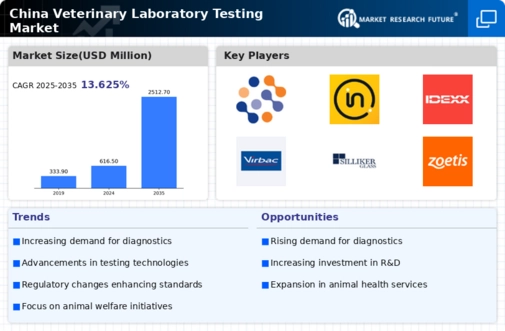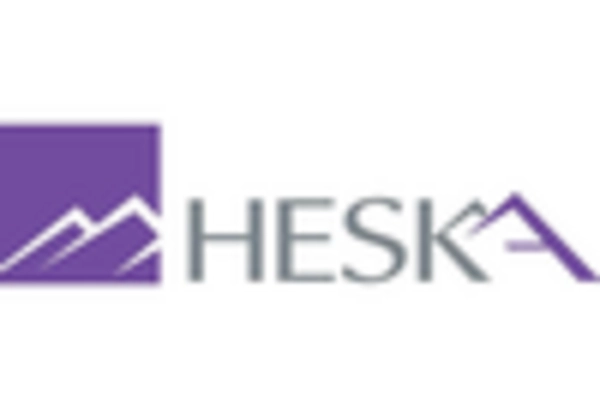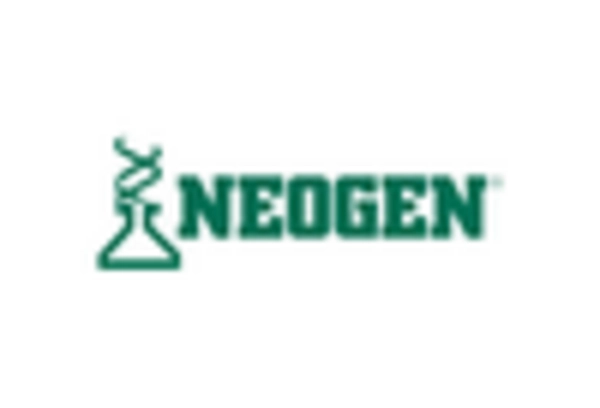Consumer Awareness and Education
Consumer awareness and education regarding animal health are increasingly influencing the veterinary laboratory-testing market. As pet owners become more informed about the benefits of regular health screenings and laboratory testing, the demand for these services is likely to grow. Educational campaigns by veterinary associations and organizations are helping to disseminate information about the importance of preventive care and early disease detection. This heightened awareness is expected to lead to a more proactive approach among pet owners, who may seek out veterinary laboratory services more frequently. In 2025, it is estimated that consumer spending on veterinary services, including laboratory testing, will increase by 10%, reflecting a shift towards prioritizing animal health and well-being.
Expansion of Veterinary Practices
The expansion of veterinary practices across China is a critical driver for the veterinary laboratory-testing market. As more veterinary clinics and hospitals open, the demand for laboratory testing services is expected to rise correspondingly. In urban areas, the establishment of specialized veterinary facilities has become increasingly common, catering to a diverse range of animal health needs. This expansion is not only enhancing access to veterinary care but also promoting the integration of advanced diagnostic technologies. By 2025, it is anticipated that the number of veterinary clinics in China will increase by over 15%, thereby creating a larger customer base for laboratory testing services. This growth in veterinary practices is likely to stimulate innovation and competition within the veterinary laboratory-testing market.
Government Initiatives and Support
Government initiatives aimed at improving animal health standards are playing a pivotal role in shaping the veterinary laboratory-testing market. In recent years, the Chinese government has implemented various policies to enhance veterinary services and promote animal welfare. These initiatives include funding for research and development in veterinary diagnostics, as well as subsidies for veterinary practices to adopt advanced laboratory technologies. Such support is expected to foster innovation within the veterinary laboratory-testing market, encouraging the development of new testing methods and technologies. By 2026, government investments in veterinary health are projected to reach $500 million, further bolstering the capabilities of veterinary laboratories across the country.
Rising Incidence of Animal Diseases
The veterinary laboratory-testing market is significantly influenced by the rising incidence of animal diseases in China. With the increasing prevalence of zoonotic diseases and other health issues among pets and livestock, there is a heightened need for accurate and timely diagnostic testing. Reports indicate that the incidence of infectious diseases in companion animals has risen by approximately 20% over the past five years. This alarming trend underscores the necessity for effective laboratory testing to identify and manage health threats. Consequently, veterinary laboratories are likely to see an uptick in demand for diagnostic services, as veterinarians and pet owners prioritize disease prevention and management strategies.
Increasing Demand for Animal Health Services
The veterinary laboratory-testing market in China is experiencing a notable surge in demand for animal health services. This trend is largely driven by the growing awareness among pet owners regarding the importance of preventive healthcare for their animals. As pet ownership rises, the need for regular health check-ups and diagnostic testing becomes more pronounced. In 2024, the market for veterinary services in China was valued at approximately $3 billion, with laboratory testing accounting for a significant portion of this figure. The increasing focus on early disease detection and management is likely to propel The veterinary laboratory testing market further, as pet owners seek reliable and efficient testing solutions to ensure the well-being of their animals.

















Leave a Comment